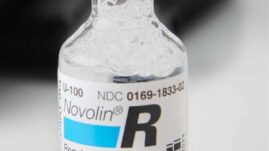This post may contain affiliate links. Please read our disclosure.
Being a pharmacist, I have often been asked if it’s safe to use expired insulin and how to tell if insulin has gone bad from exposure to heat or cold.
Medications have an expiration date because their stability cannot be guaranteed, based on clinical studies, past that date.
Taking a chance on eating an expired food product is one thing; it’s quite another taking a chance on insulin that may not work at maximum capacity, and therefore may cause harm to your overall health.

Can you still use insulin after the expiration date?
Using expired insulin is absolutely not recommended and should only be done if you have no other option.
The effectiveness of insulin degrades over time and it’s impossible to predict how well expired insulin will work – or if it will even work at all!
Insulin is a bit unusual in that it had two expiration dates; one is the expiration date if insulin is unopened and stored at the proper temperature. The second expiration date is the date the manufacturer suggests insulin is good for after opening and when kept at room temperature.
Be sure to check both dates so you know if your insulin is still safe to use.
What happens if you use expired insulin?
When insulin is not working properly, it’s akin to what happens upon an initial diabetes diagnosis when your pancreas is not producing adequate insulin for your body’s needs.
Blood sugars start to rise and can do so quite rapidly. When you see blood sugars go up and have ruled out other causes, such as illness, changes in diet and/or exercise, or new medications, start to suspect that your insulin has gone bad.
When you switch to a new vial or pen and your blood sugars “magically” go back to normal, you have verified that your insulin was in fact damaged.
It’s important to note that insulin can go bad before its expiration date. This happens very rarely, but if you feel that your insulin isn’t working as well as it should, try switching to a new vial or pen.
How can you tell if insulin has gone bad?
There are two ways in which you can tell if your insulin has gone bad.
The first method is visual inspection. If your insulin looks cloudy or discolored in any way, don’t use it. If it has clumps or what look like little “strings” in it, it’s probably not safe to use.
The second way to know your insulin is not working properly is unexplained high blood sugars, as mentioned above.
How to store insulin
Proper insulin storage is important to ensure that the insulin stays effective.
Avoid exposing insulin products to extreme temperatures. Insulin is a protein and this makes it subject to degradation (breakdown) when temperatures are too hot or too cold. Additionally, keep insulin products away from direct sunlight as this can also cause a breakdown of the insulin.
Proper insulin storage is so important that the FDA recently took action to ensure that Insulin pens must always be dispensed in their “original boxes” so that instructions for the proper use and storage of insulin are always included. This means that your pharmacy is not allowed to give you just 2 insulin pens from a box of 6 pens.
Insulin that is not being used should be stored in the refrigerator at 36°F to 46°F (2°C to 8°C), a safe distance away from the back and top of the refrigerator where cooling elements may cause the temperature to approach freezing.
The refrigerator’s butter compartment or produce drawer is typically a good option for insulin storage.
Update: A new study from 2021 shows that insulin stored at 77° to 98.6°F (25°C to 37°C) for four weeks showed the same stability as insulin stored at the currently recommended pharmaceutical protocols of 36° to 46°F (2°C to 8°C) until opened.
Any insulin vials or pen that are “in use” can be stored outside of the refrigerator at temperatures up to 86F or 30C (always check manufacturer product inserts for exact instructions).
The reason for storing in-use insulin at room temperature is that cold insulin can produce a more painful injection.
When should you throw away an open insulin vial or pen?
Many insulin pens can last outside of the refrigerator for 7-28 days, in some cases even more.
Here are some specific recommendations for insulin storage that you can follow. As always, check the instructions inside the box for specific guidance.
New insulins are coming to market at a rapid pace, and the instructions may vary slightly with different formulations and brands.
All times below are from when you open the vial or pen.
- Insulin Glargine (Basaglar®): Throw away pen/vials after 28 days.
- Insulin Lispro (Humalog®): Throw away pen/vials after 28 days of use.
- Humulin R: Throw away vials after 31 days of use. If pen, throw away after 28 days.
- Humulin N: Throw away vials after 31 days of use. If pen, throw away after 14 days.
- Humulin 70/30: Throw away vials after 31 days of use. If pen, throw away after 10 days, even if it still has insulin left in it.
- Insulin aspart (Fiasp®, Novolog®, NovoRapid®): Pen and vial, throw away after 28 days.
- Insulin degludec injection (Tresiba®): Pen and vial, throw away after 56 days.
- Insulin detemir injection (Levemir®): Pen and vial, throw away after 42 days.
- Isophane insulin human suspension (Novilin® N NPH): Vial – 42 days; pen – 28 days.
- Insulin human injection (Novolin® R): Vial – 42 days; pen – 28 days.
- 70% human insulin isophane suspension and 30% human insulin injection (Novolin® 70/30): Vial – 42 days; pen – 28 days.
- Novolin NPH and R also represent the ReliOn ® brand available at Wal-Mart.
- Insulin lispro injection (Admelog®): Pen and vial, throw away after 28 days
- Insulin glulisine injection (Apidra®): 28 days
- Insulin glargine injection (Lantus®): 28 days
- Insulin glargine injection (Toujeo®): 28 days
For questions about a particular brand of insulin, problems, or concerns about product stability, contact the manufacturer for help (links above), and in some cases, ask for a replacement.
Products to help store insulin safely
Just as new insulins have rapidly been developed, more efficient methods of keeping insulin safe have evolved as well.
Three such products have now come forward with unique and simple ways to carry insulin products with you, whether it be on short hikes, or traveling the world.
MedAngel is a handy “smart thermometer” for medications that need to be stored at certain temperature ranges. You keep it next to your insulin and it will alert you on your phone if the temperature is out of range. You can customize the temperature range for your specific medication, which is great.
Frio Cooling Packs can work up to 5 times longer than ice packs and seem to keep insulin products at a more consistent temperature. They can last up to 45 hours or more and are easy to store and use, coming in a variety of styles and colors. They require soaking in water before use as instructed on the website.
The Vivi Cap is a cooling device for insulin pens. It simply clicks onto an insulin pen instead of the cap and with the push of a button, the device then works to keep insulin at the proper temperature for as long as you need it to. No ice packs or preparation is necessary. The battery lasts as long as the device, which can be active for several years.



Niecy
So far I haven’t seen a post regarding Lantus (unless I missed it). May Lantus expired
March of 2025. Do you think that it has lost its potency? Or are all insulins baically the same when it comes to expiration dates?
Christel Oerum, MS
It could have. Ideally you’d discard it but some find (myself included) that it will still lower blood sugars after the expiration date.